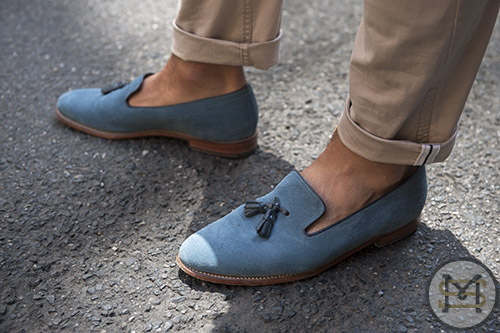Interview: Rone
“I do become conscious of what I paint and what people expect me to paint. It’s good and bad: you become a slave to your style but there is also an ownership of a style that I’m proud of – that idea of sticking to you guns.”
- Rone
Rone in his new Collingwood studio
There is a moment in Rone's new Collingwood studio that catches both the artist himself and Makers a little by surprise. Seated by a window as our photographer takes aim, the scene is interrupted by a voice from the street. “Can I take your photo,” comes the request. Rone nods in good humour and throws up a peace sign. The contented street snapper wanders off, but not before thanking him by name.
“That guy knew my name,” Rone says with a grin, shaking his head a little. “It’s weird when it happens, and it’s happening more and more. It’s especially strange when it happens in other countries: I get recognised in Miami a lot, and in London because I’ve been doing a lot of promo for the exhibition.”
London 2013
Perhaps Rone shouldn’t be surprised.
More than 10 years after his beginnings experimenting with graffiti stencil art, the 30-something artist has become a fixture on the international street art scene courtesy of the stunning female faces that have captured the imaginations of all who view them.
Seductive, soft and in stunning contrast to the masculinity of the concrete spaces upon which they are painted, his choice of subject proved eye-catching for its very feminine energy.
Rone: “The idea behind the women was that everything in street art and graffiti was very macho at that time. You’d have a screaming face, or a really sexy girl or an angry looking Frankenstein guy. To have this calming beauty was different to all of that. It’s not shouting and it wasn’t over-awing, but I was painting in this overwhelming size so the piece still had presence. And, being posters, they would fall apart and decay but they still held their beauty. I love that juxtaposition, I loved how they looked on the street.”
Paris 2011
Clearly he wasn’t the only one. In the past few years Rone's success is such that he has been able to give up his graphic design day job and become a full time artist: one who has in the past few months held a solo exhibition at London’s Stolen Space Gallery, as well as painting a multi storey wall (by commission) in Berlin as part of a project with Strychnin Gallery.
Just a few weeks ago he stopped traffic in the CBD, moving in a cherry picker to allow completion on a project for Rue & Co’s newly opened shipping container dining precinct at the Paris end of Collins Street.
It is the kind of success that has allowed him (along with his Everfresh crew of likeminded Melbourne artists) to occupy a bigger and better warehouse studio space off Collingwood’s increasingly gentrified Smith Street.
That is, when he is in town at all: international invitations to various events and festivals call thick and fast. Makers catch him just before he jets off again, this time to Taiwan for Pow Wow.
Rone: “I didn’t see myself here. Go back 10 years and the only successful street art graffiti artist, the biggest thing they were doing, was a tee shirt brand. Just to be purely living off the artwork – it was impossible. I had never intended to do it. I never studied art. I studied graphic art and I was pretty happy making my income there. This was something I always did for fun and now, 10 years later one took over the other…”
Not that Rone sees his success as merely a happy accident. He has immense appreciation for the street art movement, admitting to finding something exciting in seeing people operate outside the “flow of things”, in working out their own way to creative success beyond the traditional routes of art school and under studies.
He also knows well the trials of being seen and heard in what is fast becoming one of the biggest art movements in recent times.
Rone: “With graffiti you can start right now. You don’t need any training. And while that doesn’t mean you’re good, in that sense the numbers of people playing the game means it’s quite hard to get your name out there.”
Perhaps it’s for this reason – his visibility in a field of wannabes – that one finds it impossible not to appreciate his genuine sense of gratitude. There is the grin that stretches ear to ear, of course, but – more than that – this incredible feeling of enthusiasm and glee that he exudes for the place he currently finds himself.
Certainly one gets the strong sense that, somewhere along the way, Rone has fully made the transition to legitimate artist: he is unapologetic about his preference to paint canvas for private commissions and no longer works illegally.
Berlin 2013
There is also the due diligence being given to the evolution of his style, something the painter is conscious of contemplating as he moves in to the next phase of his career. Not to mention his awareness around balancing the offers of international travel against time that must be spent creating in the Melbourne studio.
Rone: “It’s surreal. This month I had to think about whether I was going to go to Taiwan or go to San Miguel, Mexico, because I need time to paint because that’s how I make my money. So these are my problems now – my ridiculously good problems. It’s a life I couldn’t have imagined having five years ago.”



















































































